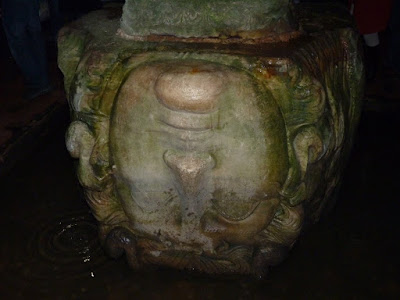Saturday we went to see the Basilica Cistern. It's a large, underground cistern that was built in the 6th century. A basilica used to sit above it (hence the name), but was destroyed in a fire. The Basilica Cistern is the largest of hundreds of cisterns underneath Istanbul. It used to provide water for the Great Palace of Constantinople and Topkapı Palace, among other buildings.

The English portion of the sign just outside the entrance.
The Basilica Cistern is just a short walk from either the Hagia Sophia/Blue Mosque area or from Topkapı Palace. It's nearly right in between them.

Columns.
There are 336 marble columns, 12 rows of 28. The whole effect is rather neat, as it's dark and damp, and the lighting of the cistern is a bit eerie. Water drips from the ceiling overhead as you walk through the cistern, and carp swim in the 2-3 feet of water in the bottom.

Mmm, carp. Did you know that in Poland the carp is considered the king of fishes? It's like the equivalent of salmon or Mahi-Mahi in America. They eat it for Christmas dinner. Strange, huh?
There is one column in the cistern that is covered in "Peacock eyes" and tears. Ancient texts suggest that the tears pay tribute to the hundreds of slaves who died during the construction of the cistern.

The "Peacock-eyed" column.
There are also two Medusa heads in the cisterns which are the bases for two of the columns. It's said that they were probably relocated to the cistern from other Roman buildings, but nobody knows for sure. One is upside-down and the other is sideways, and while once again, nobody is sure why, they were probably put that way on purpose, and it probably had to do with structural integrity of the cistern.

Upside-down Medusa head.
Most of us have heard the legend about Medusa. She had hair of snakes and everyone who looked at her would turn to stone. There's more to the legend, or Greek myth, but of course there are conflicting stories so there's no telling which myth is correct (ha, what a contradiction!). Anyhow, what I found interesting was that because of her "ability" to turn anyone who looked at her to stone, images of Medusa (and the two other Gorgons) were often used to protect great buildings.

Sideways Medusa head.
All in all, the Basilica Cistern was pretty neat. I've heard that it's awesome to visit in the summer, because it's naturally cool and provides a great break from the heat. At only 10 lira for admission, I'd recommend visiting. It would take a maximum of 30 minutes to leisurely look at everything. Be forewarned that if you have a young child in tow, the railings are spaced far apart (2-3 feet apart, at least. Definitely far enough apart that a child could fall in) and the floor is slippery.


I love how you become tourists in your own town. I really need to start doing that. I feel like we will go back home and I will regret all of the things I didn't do.
ReplyDeleteeek - thanks for the warning about the railings. Is a stroller possible down there?
ReplyDeleteUmm, you could bring a stroller, but you'd have to carry it down 52 steps and then back up, and deal with a few steps down there as well. It's doable.
ReplyDeleteThis is incredible. I have to admit that I had absolutely no idea what a cistern was. Or that it was this jaw droppingly stunning. I bet it is even better in real life. Thanks for sharing!
ReplyDelete